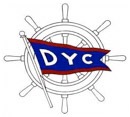Detroit Yacht Club
| |
This article does not cite any references or sources. Please help improve this article by adding citations to reliable sources. Unsourced material may be challenged and removed. (May 2010) |
| File:Burgee of detroityc.svg Burgee | |
| Founded | 1868 |
|---|---|
| Clubhouse | One Riverbank Road Belle Isle, Detroit, MI 48207 |
| Country | |
| Website | http://www.dyc.com |
The Detroit Yacht Club (DYC) is a private marina and sailing club in Detroit, Michigan, located on its own island off of Belle Isle in the Detroit River between the MacArthur Bridge and the DTE generating plant. The DYC clubhouse is a restored 1920s Mediterranean-style villa that is the largest yacht club in the United States.
DYC is a member of the Detroit Regional Yacht-racing Association (DRYA).
Contents
History
The club was founded by Detroit sailing enthusiasts in the late 1870s with a small clubhouse and boatshed. The original location was at the foot of McDougall Street, just south of Jefferson Avenue. In the early 1880s, the members were divided over the club's growing social activities, and in 1882,one group broke away to form the Michigan Yacht Club. The remainder elected James Skiffington Commodore (the club's title equivalent to the "President" of other recreational and social organizations) in 1884.
The original Belle Isle clubhouse was built at a cost of $10,000 (with a further $2,000 for furnishings) in 1891, but burned down in 1904. A new facility was quickly built at the same site.
In 1923, the present-day clubhouse was dedicated; its construction had cost more than one million dollars, the work of architect George Mason, who also designed Detroit's Masonic Temple (the world's largest) and the opulent Gem Theatre. By the end of the following year membership had reached 3000. Prominent member and Commodore Gar Wood set world speed records in hydroplanes, and with his Gold Cup victories brought the club to national and even worldwide prominence. Beginning in 1921, the DYC started sponsoring the hydroplane races. Membership declined dramatically during the Great Depression, and some services were suspended.
In 1946, all bonds had been paid, and the club was debt-free. The club's women formed the first women's sailing organization in the country and raced the club's catboats. During the next decade, dining facilities would be expanded, and theater-quality projection equipment installed in the ballroom, where Sunday evening screenings became a regular feature of club life. There has recently been an effort to bring back Sunday night movies.
During the 1960s, an outdoor, Olympic-size swimming pool was added, and the West End docks were built, increasing the number of boat wells to over 350. The DYC has long been a symbol of privilege and exclusivity. Up until the 1970s, Black applicants were routinely rejected, until psychiatrist Dr. Leonard Ellison filed a lawsuit, and became the first Black member.[1]
More recently, the club has added additional facilities like a fitness center and have opened the Bitter End lounge area to allow for women to enter. Before the restoration, the Bitter End could only be accessed through the men's locker room. The newly restored Bitter End is also used for hosting small parties.
Club Facilities
- Racquetball Courts
- Indoor and Outdoor Pools
- Outdoor Hot Tub
- Outdoor Tennis courts
- Bocce Ball Court
- Volleyball Court
- Indoor and outdoor restaurant
- Marina for over 300 boats
Annual Events
- Officer's Ball (Often called Commodore's Ball)
- Vice Commodore's Ball (Also called Clean-up Day)
- Memorial Day Celebration
- Hydroplane Racing Weekend
- Venetian Weekend
Groups within the club
- The Outriggers
- The Pelicans
- Metro Club
- Ski Club
- Garden Club
- Sea Serpents
- Kayak Club
- Rod and Gun club
- The Voyagers
- The Seagulls
- DYC Business Networking group
Notable members
- Gar Wood (former Commodore)
- Edsel Ford
- Horace Dodge
- Charles Kettering
- Gus Schantz
- Fred Fisher
- Robert Oakman
External links
| |||||||||||
Coordinates: 42°20′55.96″N 82°58′25.38″W / 42.3488778°N 82.9737167°W

